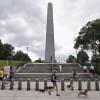Advisory: This story includes descriptions of violence, abuse and oppression of Black and Indigenous people, which were the norm in colonial-era Boston.
Enslaved people have returned to Faneuil Hall.
In June, Boston opened an exhibit at the historic Faneuil Hall that documents the stories of enslaved people in colonial Boston, including a database listing more than 1,300 individuals who have been identified, though in many cases their names and other personal details remain unknown.
Some local activists opposed the exhibit’s location. Faneuil Hall is named for Peter Faneuil, who the city’s own website says “was personally responsible for trafficking African captives to Boston where they were enslaved.”
Faneuil Hall, which opened in 1742, is one of Boston’s most visited tourist sites. It is known as a colonial marketplace as well as a gathering hall for speeches and strategy sessions among colonial activists agitating for liberation from England.
“As revolutionaries, abolitionists, suffragists, and modern-day activists adopted Faneuil Hall as the site of their speeches, protests, and celebrations, the memory of a generous man slowly replaced the reality of a successful merchant with strong connections to slavery,” the National Park Service now admits.
Faneuil was one of colonial Boston’s wealthiest men, a fortune built on an Atlantic shipping business that was intimately tied to the slave trade. Faneuil built his empire transporting enslaved people and the products they harvested, such as sugar and molasses produced by enslaved workers and low-grade cod shipped from New England to the West Indies to feed enslaved plantation workers.
His wealth allowed Faneuil to keep several enslaved people in his household and to build the hall as a gift to Boston.
Faneuil Hall became both a marketplace and a public gathering place that for years continued to support the slave trade. Boston has excavated all varieties of commercial canisters from under the hall that were manufactured by enslaved people to carry goods produced by their labor. Enslaved people also were bought and sold in the marketplace outside Faneuil Hall.
Peter Faneuil is buried in a large tomb at the Granary Burial Ground, a few steps away from John Hancock. No mention is made there of the source of his wealth.
This story is part of the project Enslavement History of the Freedom Trail , a collaborative effort between GBH News and Boston University students to detail the mostly hidden history behind some of Boston's most well-known sites.








